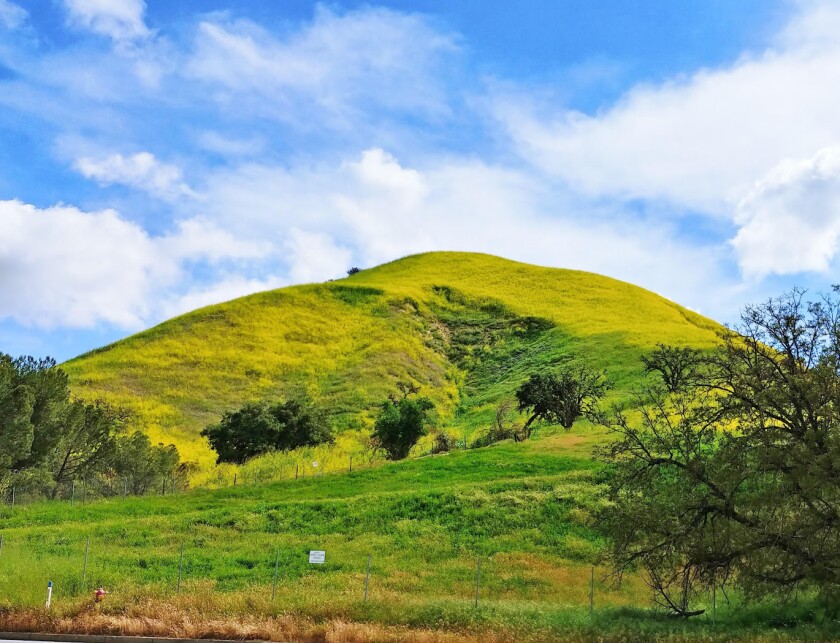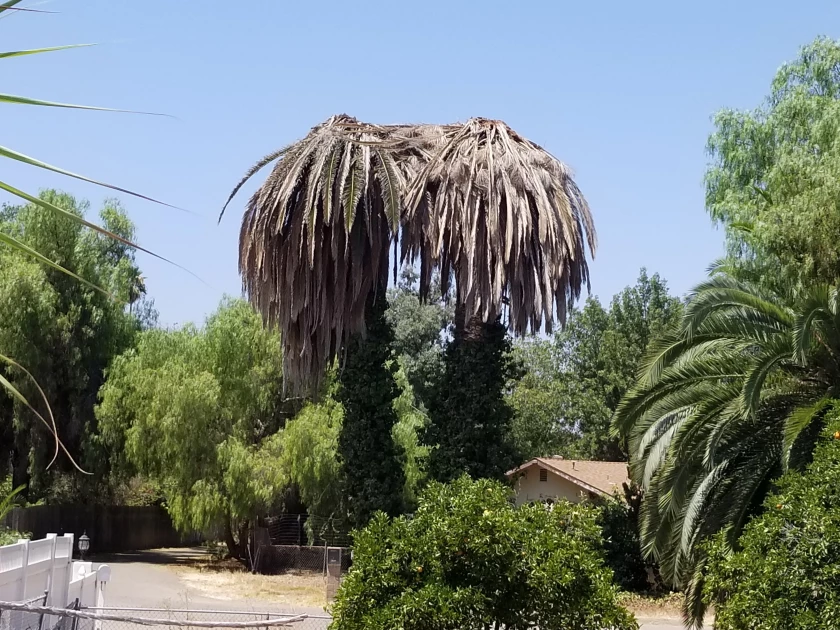Combating ‘Invasion of the Habitat Snatchers’

Linda Jones
Nonnative plants rob native species of water, nutrients, space to grow
BY LINDA JONES
(This article originally appeared in the San Diego Union-Tribune on August 13, 2022)
Have you noticed dead Canary Island palms (Phoenix canariensis)? Hills covered with bright yellow flowers in spring or with dried nonnative grasses in summer? Maybe you’ve seen waterways clogged by plants or maybe ants and rats in your yard? These are some of the invasive species that have made San Diego County their new home. These plants and animals cause changes to the ecosystem that result in serious ecological problems.
In addition to environmental impacts, there is an economic impact: The state of California spends about $3 billion annually for control and eradication of invasive species. Farmers and home gardeners also spend time and money on pesticides and herbicides to control invasive pests. Additionally, nonnative grasses are “flash fuels” for wildfires, increasing the level of destruction, environmental and economic losses.
What are invasive species and how did they get here? Let’s clarify the differences between types of species. A native species (plant or animal) has existed here historically (prior to European settlement) and has co-evolved over time with other species, including predators in the ecosystem. For example, Cleveland sage (Salvia clevelandii) is a native species to San Diego County.
A naturalized species is a nonnative species that has entered natural areas. These species are able to reproduce and maintain their populations without help from humans: no extra water, no fertilizers, no pesticides. However, they are generally not a functioning part of that new ecosystem. Two examples are red hot poker (Kniphofia uvaria) and Japanese honeysuckle (Lonicera japonica).
A small percentage of these naturalized species become invasive. They not only escape to natural areas but use water, nutrients and space needed by native plant species. Importantly, they do not generally provide food or habitat for native wildlife. And they keep spreading, like the invasive species pampas grass (Cortaderia selloana).
Invasive species degrade our natural areas, including areas critical to threatened and endangered species, by taking resources from native life forms. In natural areas and parks, they suppress native and more desirable species, even changing the composition and structure of the ecosystem. Many of our native birds and insects depend on specific native plants for their survival; when invasive plants and animals destroy the native habitat, these animals do not survive.
How do invasive species get here? With globalization, they come in a wide variety of ways: on planes, trains, trucks and cars; in packing materials (e.g., green crabs); on plants brought from other areas and plants in the nursery trade. They stick to clothes and fur. About 63 percent of our invasive plant species are the result of introductions for landscaping, animal forage, or human food and medicine.

A Canary Island palm infested with the South American palm weevil.(Leah Taylor)
In 2011, the South American palm weevil (Rhynchophorus palmarum) flew into San Diego from Mexico, wreaking havoc on palm trees, particularly the Canary Island date palm — which is also an invasive plant due to the copious number of seeds it produces. In less than 10 years, the weevil has spread from the Mexican border as far north as La Jolla. Dead palms can be seen along freeways and streets. Since the weevil has no natural predators in San Diego, repeated application of systemic chemicals is currently used to treat weevil infestation. The preventative spraying and removal of dead palms are both costly.
In spring, our hills are alive with bright yellow blooms. The bad news is that this burst of color is usually an invasive mustard plant (Brassica nigra). It is unclear when and how it was brought here — by the mission padres to mark their trails, or in hay brought in for livestock, or in palm trees — but however it came, mustard species now cover many of our coastal mountains, foothills and desert areas. The mustards rob native plants of water and crowd out the native wildflowers that used to cover our hills in rich color each spring.
Brushfire is another issue made worse by invasives. Grasses brought in for livestock feed escaped and have invaded natural areas. These dry grasses increase the frequency and intensity of fires. They reseed quickly, preventing native plants from establishing in burned areas. With climate changes, wildfires are likely to increase, causing both higher economic and personal costs.
There are some ways you can help prevent the devastation of natural areas by invasive species and keep invasive species out of your garden.
1. Do not bring any plants (or plant parts) or wildlife into our region that are not here naturally. Similarly, don’t release animals or aquarium plants into the wild. Plants, animals and even food can carry pests or disease or can become invasive.
2. After hiking in natural areas, clean your boots and gear to get rid of hitchhiking seeds and pathogens.
3. Learn which plants and animals are invasive in your area. There are many online resources that identify invasive species and even suggest alternative plants for your garden. Visit the website plantright.org for a list of invasive plants in California and for better alternatives to plant.
4. Educate local nurseries and tell them that you do not want to host invasive species in your garden. Many nurseries no longer sell invasive plant species, and tools are being developed to help them assess the potential of newly developed varieties for invasiveness.
5. If possible, remove invasive plants from your garden. Dispose of the seeds and reproductive parts in plastic bags in the trash, not in the green waste.
6. Support organizations that work to remove invasive species. There are a number of organizations, local parks and wildlife refuges that use volunteers to help remove invasives.
Armed with these methods for preventing invasives from entering our gardens and habitats, you can help conserve our native plants and animals.
Jones is a UCCE Master Gardener in San Diego and has taught Beginning Vegetable Gardening classes. As a native San Diegan and an ecologist, she is interested in learning and sharing information about our native plants, wildlife and ecosystems.

